
Wine Culture and Information since 2002 - Volume 22
 Wine Culture and Information since 2002 - Volume 22 |
|
Issue 182, March 2019 |
Contents |
|
|
Sangiovese: Divine Soul |
|
Writing about my favorite grapes and wines is something I already did in the past. It is never easy – in these cases – to express an absolute and definitive position because, to tell the truth, there are so many wines and grapes I consider as favorite ones. Pinot Noir, Nebbiolo, Sagrantino, Verdicchio, Fiano, Sauvignon Blanc, Marsala – and the list would be rather long – they are just a small part of what I like to pour into my very personal glass. In the list of my favorites there are, of course, also the grapes and wines of my land – Umbria – a constant presence for me that has always filled my glasses. I therefore add Grechetto, Trebbiano Spoletino, the aforementioned Sagrantino, the emerging and recently rediscovered Grero, in addition to the grape that was definitely the protagonist before the unstoppable success of the red grape from Montefalco: Sangiovese. It is not, and this is something well-known to anyone, a variety of Umbrian origin – to tell the truth, it was introduced in this region in relatively recent times – however present in the vineyards of the green heart of Italy. Grape of extraordinary personality, Sangiovese gives life to great wines of enormous and proven class and elegance, also thanks to its vast presence in the Italian territory. It should be noted that, his Majesty Sangiovese, is virtually present in almost all Italian regions, in fact, it is among the main grapes grown in the Bel Paese. The magnificence and charm of Sangiovese is not limited to Italy only: this great red grape is in fact also found in other wine-making countries of the world, giving birth to interesting enological interpretations. Talking about Sangiovese unmistakably means referring to the great wines of Tuscany – Brunello di Montalcino, Chianti and Vino Nobile di Montepulciano, just to name a few – however it is also capable of producing wine excellence in other Italian regions as well. The sons of Sangiovese can always be recognized in the glasses, even in those cases, so to speak, humble and modest. It is not easy to talk about Sangiovese as a “unique” variety, as it is an extremely prolific grape in terms of clones, a differentiation that is the result of both its long history and the adaptation processes, occurred over time, in the different territories where it is cultivated. Talking, therefore, about the expression of Sangiovese within a territory, also means considering the relative clone. In fact, we must note the enormous sensorial differences uniting and dividing at the same time the many wines from Sangiovese produced in Italy. It is not just a matter of regional differences, but, above all, territorial ones with strong changes occurring even in vineyards a few kilometers away one from each other. In fact, it is very likely the differences are mainly determined by the type of clone and not only by the territory and its microclimate. In general terms, in fact, it does not make much sense to compare, for example, a Brunello di Montalcino to a Romagna Sangiovese Superiore: two very different wines, however excellent, and not only for geographical reasons. Sangiovese is a grape of huge versatility, capable of giving a noble personality to its wines. One of the qualities I like about Sangiovese, is the pleasant acidity which is always perceived in its wines: not only capable of giving balance, but, above all, a touch of noble elegance. A grape not exactly rich in coloring substances – it must be said, a rather variable quality depending on the clone – Sangiovese produces wines with a sensation of moderate astringency, just another touch of elegance. As for the capability of producing alcohol, Sangiovese can be very generous, however – thanks to its pleasant acidity and moderate astringency – its wines reach a perfect balance, even when vinified in inert containers. In fact, these Sangiovese wines can be enjoyed for their immediacy, the frank and direct character of the great Italian red grape, making even the simplest style both rich and expressive. Moreover, Sangiovese is well suited for the vinification in wood – both in large cask and in barrique – something that has been known for a long time and many are the wines obtained from this grape and produced in this way. It is in fact enough to think about Brunello di Montalcino, Chianti, Vino Nobile di Montepulciano, as well as many other Sangiovese wines produced in Italy, to have a minimal list of the style produced in cask. Even in these cases, Sangiovese fully expresses its elegant personality, in which it is always perceived its characteristic crispness given by acidity. The vinification of Sangiovese in wood, moreover, increases both structure and astringency, also giving – according to time – a pleasant roundness which tends to balance its crispness. The vinification of Sangiovese in cask is, in any case, an operation requiring “a certain skill” – something true for any other wine, after all – as the excessive impact of wood tends to cover the aromas of flowers and red fruits of this grape. A fatal mistake that would transform the aromatic elegance of Sangiovese into a joke of carpentry. Sangiovese is capable of making other wonders as well. This magnificent red grape, in fact, is also used for the production of sweet wines – such as the charming Occhio di Pernice produced in Montepulciano – as well as white and sparkling wines. These styles, it must be said, represent a small part of the vast production of red wines produced with Sangiovese, however, even in these cases, it does not fail to prove its elegance and personality. The charm and finesse of Occhio di Pernice represent a magnificent tribute to the greatness of Sangiovese also in sweet style from dried grapes. What about the relationship between Sangiovese and time? When properly vinified for this purpose, wines produced with Sangiovese are capable of challenging time even for dozens of years, while developing an enormous complexity without ever losing elegance. Finally, accommodating and welcoming, Sangiovese can be successfully blended to other grapes to give life to new wine making interpretations of great class. A grape with a divine soul, a magnificent interpreter of divine wines. Long live the king Sangiovese! Antonello Biancalana
|
||||
Contrasts of Ciliegiolo and RuchéThis month in our glasses we are pouring again two wines made from red grapes, the former typical in Central Italy, the latter takes its fame from the wines of Castagnole Monferrato, in province of Asti |
|
In the tasting by contrast of this month we will pour into our glasses again two wines produced with red grapes. They are varieties that, undeniably, do not enjoy the fame and notoriety of other Italian grapes, however they have been able to prove – with facts – their wine making talent through their respective wines. It must be said, as this happens and happened for many grapes, the enological history of the two protagonists of our tasting by contrast is similar, in some respects, to that of the ugly duckling. It must be noted both Ciliegiolo and Ruché – the two grapes we will pour this month in our glasses – have not enjoyed a notable reputation in the past. As this has been taught so many times in the history of modern enological, thanks to the good use of the technique in the vineyard and in the winery, no less important, a better viticultural awareness, these two grapes today are capable of giving our senses quality wines with valuable sensory characteristics. In particular Ruché, which owes its fame to the wines produced in Castagnole Monferrato, in the province of Asti, a success allowing it to reach the peak of the Olympus of Italian quality by receiving the Denominazione d'Origine Controllata e Garantita ranking. This interesting Piedmontese grape has in fact proved to give life to wines that are unique in their kind, having an interesting personality and character. Ciliegiolo, although it has not enjoyed an equal fame in the Italian enological quality system, after having been used for a very long time as a variety to be blended to other grapes, today has proved to be very interesting when vinified alone. In both cases, this is yet another proof of how technological progress in viticultural and wine making has allowed these and many other grapes to finally express their true potential.
|
|
Ciliegiolo is mainly found in the territories of central Italy, in particular in Tuscany, the region from which this grape is believed to have its origin. It is, in any case, a supposition, as the origins of Ciliegiolo are not entirely clear and in the past several hypotheses have been formulated, including a Spanish origin, today completely denied. The spreading of Ciliegiolo can today be considered rather modest – and it is estimated its presence in the Italian vineyards is in continuous decline – however it has been cultivated for a long time in some Italian regions, in particular those in the central area. In addition to Tuscany, as already mentioned, Ciliegiolo is also present in Umbria, Latium, Marche, Liguria, Abruzzo and Emilia Romagna. Except in very rare cases, it should be noted in these regions Ciliegiolo is mainly used blended to other varieties. As already mentioned, the origins of Ciliegiolo are unclear and even the historical records are scarce and vague. In fact, it is believed the first mention relating to this grape dates back to 1600, however this mention – just like the following ones – does not allow to exactly determine whether it actually is about the Ciliegiolo we know today. Recent genetic studies have however allowed to discover a very close link between Ciliegiolo and Aglianicone – red berried variety native to Campania – as to make it believe this grape is of ancient origins although uncertain. Moreover, according to other studies Ciliegiolo is considered a progenitor variety of Sangiovese, a theory that reinforces the hypothesis it is a grape with ancient origins. Ciliegiolo is traditionally a variety used for the production of wines blended to other grapes – in particular Sangiovese – used to give both roundness and alcohol strength, as well as to enrich the aromatic profile with sensations of red fruits.
|
||||
|
Talking about Ruché grape means – of course – talking about Castagnole Monferrato, a town in the province of Asti that has linked its name with the wines produced with this grape. The origins of this variety are not entirely clear, however it is believed it originated from the area around Castagnole Monferrato where, undeniably, it represents the main enological glory. Even the origin of the name is not completely clear and it is supposed to come from the first vineyards cultivated near a small Benedictine church dedicated to San Rocco – San Roc in local dialect – today non existing anymore and probably built in the town of Castagnole Monforte or in the nearby Portacomaro. Another hypothesis believes the name comes from the famous rocche of the southern part of Piedmont, steep and perched hills where the generous vineyards are cultivated, thanks to the favorable exposure to the sun, thus becoming ruché in the local dialect. According to some, Ruché would have been introduced into these lands from Burgundy by the Cistercian monks in the twelfth century and, in this regard, it must be noted there are no evident elements which can confirm this hypothesis. In any case, many people believe Ruché is a very old variety and its spreading is almost limited to the territory of Monferrato and with a marginal presence in the province of Alessandria, here known as Moscatellina. Ruché is capable of producing wines with good personality and its enological re-evaluation has occurred in relatively recent times, in particular, after the 1980s. A work that has allowed the understanding of the enological potential of Ruché, especially used alone, a result which made it obtain the maximum ranking of the Italian quality system: Denominazione d'Origine Controllata e Garantita (Controlled and Guaranteed Denomination of Origin, DOCG).
|
After having introduced the two varieties of this month, we can now start our tasting by contrast. The selection of wines of this month is relatively simple and should not be particularly difficult. In any case, we will make sure both wines are produced with the respective varieties alone and vinified in inert containers in order not to have any sensorial interference. As for the wine produced with Ciliegiolo, our choice will be in favor of the emerging and interesting production of the territory of Narni, a charming Umbrian town in province of Terni. The choice of the wine produced with the Piedmontese variety inevitably goes in favor of Ruché di Castagnole Monferrato, territory from which come the most interesting bottles produced with this grape. The two wines belong to the most recent vintage and are poured into their respective tasting glasses at a temperature of 17 °C. (63 °F) We pour now the two wines in their respective glasses and start the tasting by contrast of this month from the examination of appearance, that is how the wines show themselves in their aspect. The first wine we will examine is Ciliegiolo di Narni, therefore, by tilting the glass over a white surface, we observe the color at the base. Ciliegiolo reveals an intense and brilliant ruby red color, with moderate transparency: the object placed in contrast between the glass and the white surface is not perfectly visible. Nuances of Ciliegiolo – observed at the edge of the wine, near the opening of the glass – reveals a ruby red color, often tending to purple. Let's now pass to the evaluation of the appearance of Ruché di Castagnole Monferrato, by observing the color at the base of the glass. Also in this case we can easily see an intense and brilliant ruby red color. Just like the previous wine, transparency of Ruché too can be defined as moderate. Nuances of the Piedmontese wine – observed at the edge, where the wine becomes thinner – reveals a ruby red color. The olfactory profiles of Ciliegiolo and Ruché denote differences since the opening phase, that is the first sensations perceived in the nose. In both wines are smelled aromas of fruits and flowers, sometimes having the same character, however the complete development of aromas reveals substantial differences. In Ciliegiolo, in fact, we can clearly perceive aromas related to fruits and flowers, while in Ruché – in addition to these aromas – it is also possible to perceive sensations recalling spices. The olfactory evaluation of Ciliegiolo gives the nose aromas of cherry, raspberry, strawberry and plum. As for floral aromas, in Ciliegiolo we generally perceive rose, cyclamen and iris. Not so different – as for aromas recalling fruits – the profile of Ruché. To the nose reveals aromas of black cherry, plum, raspberry, blueberry and strawberry, while for aromas of flowers, in Ruché can be perceived sensations of rose and violet. In the Piedmontese grape you can also smell aromas reminiscent of spices, in particular, white pepper and nutmeg. Let's now evaluate the olfactory profiles of the two wines of our tasting by contrast, starting – just like we did in appearance analysis – from Ciliegiolo di Narni. Holding the glass in vertical position and without swirling, do the first smell in order to evaluate the opening of the wine, that is the initial aromas developing from the glass. To the nose are perceived, clean and intense, aromas of cherry, raspberry and strawberry, as well as a floral scent in which can be recognized cyclamen. Let's now swirl the glass, an operation favoring the development of the other aromas and proceed with another smell. The profile of Ciliegiolo is completed with plum, blueberry and rose. Let's now pass to the evaluation of the aromas of Ruché di Castagnole Monferrato: proceed with the first smell – keeping the glass still and in a vertical position – and assess the opening of the wine. To the nose can be perceived aromas of black cherry, plum and strawberry, followed by a floral scent of rose. After having swirled the glass, the profile of Ruché is completed with raspberry, blueberry and violet as well as spicy hints in which we can be perceived the aroma of white pepper. Let's now pass to the evaluation of the gustatory profiles of Ciliegiolo and Ruché, starting, just like the previous phases, from the Umbrian wine produced in Narni. We begin with the evaluation of the attack, that is, the main gustatory sensations the wines give the mouth at the first sip. The initial organoleptic qualities of Ciliegiolo are expressed with a moderate pseudo-burning perception produced by alcohol as well as a pleasant roundness which tends to attenuate crispness, a characteristic that in wines produced with this grape is however modest. We perceive the flavors of cherry, raspberry and strawberry, confirming the good correspondence to the nose. The structure of Ciliegiolo is moderate as well as its astringency. Let's now pass to the evaluation of Ruché di Castagnole di Monferrato's attack and take a sip of this wine. In the mouth can be perceived a good structure and pleasant roundness, with a pseudo-burning sensation produced by alcohol. Crispness and astringency are slightly stronger than in Ciliegiolo. In the mouth we perceive flavors of black cherry, plum, raspberry and strawberry, sometimes followed by a spicy touch reminiscent of white pepper. The final phase of the tasting is related to the sensations the wines leave in the mouth after swallowing. The finish of Ciliegiolo di Narni is characterized by a good taste-olfactory persistence in which the pleasant sensation of roundness continues to be perceived, confirming – also in this phase – the modest acidity of this grape. It can also be perceived flavors of cherry, raspberry and strawberry, followed by a sensation of moderate structure. The finish of Ruché di Castagnole Monferrato is of good taste-olfactory persistence, leaving in the mouth a sensation of perceptible roundness and, compared to Ciliegiolo, a more intense sensation of astringency and structure. In the mouth are perceived flavors of black cherry, raspberry, plum and strawberry, in addition to the pleasing spicy sensation in which can be recognized white pepper. Finally, we perform a last gustatory evaluation of the two wines, taking a sip of Ciliegiolo and then of Ruché: the differences produced in the mouth by the two wines are evident, in particular acidity and astringency.
|
||||||||
Wines of the Month |
|
|
|
Score legend Prices are to be considered as indicative. Prices may vary according to the country or the shop where wines are bought |
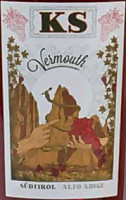
|
|
KS Vermouth Rosso |
|
| Roner (Alto Adige, Italy) | |
 Other Grapes Other Grapes | |
| Price: € 20.65 | Score: |
 Brilliant ruby red and nuances of brick red, moderate transparency. Brilliant ruby red and nuances of brick red, moderate transparency. Intense, clean, pleasing and refined, starts with hints of cherries in
alcohol, cinnamon and artemisia followed by aromas of cinnamon, star anise,
red orange and gentian. Intense, clean, pleasing and refined, starts with hints of cherries in
alcohol, cinnamon and artemisia followed by aromas of cinnamon, star anise,
red orange and gentian.
 Sweet attack with a pleasing astringency, however balanced by alcohol,
good body, intense flavors, agreeable. Sweet attack with a pleasing astringency, however balanced by alcohol,
good body, intense flavors, agreeable.
 Persistent finish with flavors of artemisia, cherries in alcohol and
red orange. Persistent finish with flavors of artemisia, cherries in alcohol and
red orange.
 Aromatized red wine. Aromatized red wine. |
|
 Aperitif, Fruit tarts Aperitif, Fruit tarts |
|

|
|
Saino 2015 |
|
| Cordeschi (Latium, Italy) | |
 Sangiovese, Cabernet Sauvignon Sangiovese, Cabernet Sauvignon | |
| Price: € 12.00 | Score: |
 Brilliant ruby red and nuances of garnet red, moderate transparency. Brilliant ruby red and nuances of garnet red, moderate transparency. Intense, clean, pleasing and refined, starts with hints of black
cherry, plum and black current followed by aromas of violet, blueberry,
raspberry, carob and vanilla. Intense, clean, pleasing and refined, starts with hints of black
cherry, plum and black current followed by aromas of violet, blueberry,
raspberry, carob and vanilla.
 Properly tannic attack and however balanced by alcohol, good body,
intense flavors, agreeable. Properly tannic attack and however balanced by alcohol, good body,
intense flavors, agreeable.
 Persistent finish with flavors of black cherry, plum and black currant. Persistent finish with flavors of black cherry, plum and black currant. 11 months in barrique. 11 months in barrique. |
|
 Broiled meat and barbecue, Roasted meat, Stewed meat with mushrooms, Cheese Broiled meat and barbecue, Roasted meat, Stewed meat with mushrooms, Cheese |
|

|
|
Ost 2014 |
|
| Cordeschi (Latium, Italy) | |
 Sangiovese Sangiovese | |
| Price: € 15.00 | Score: |
 Brilliant ruby red and nuances of ruby red, moderate transparency. Brilliant ruby red and nuances of ruby red, moderate transparency. Intense, clean, pleasing and refined, starts with hints of black
cherry, plum and violet followed by aromas of raspberry, blueberry, carob,
vanilla and menthol. Intense, clean, pleasing and refined, starts with hints of black
cherry, plum and violet followed by aromas of raspberry, blueberry, carob,
vanilla and menthol.
 Properly tannic attack and however balanced by alcohol, good body,
intense flavors, pleasing crispness. Properly tannic attack and however balanced by alcohol, good body,
intense flavors, pleasing crispness.
 Persistent finish with flavors of black cherry, plum and raspberry. Persistent finish with flavors of black cherry, plum and raspberry. 13 months in barrique. 13 months in barrique. |
|
 Stuffed pasta, Broiled meat and barbecue, Stewed meat with mushrooms Stuffed pasta, Broiled meat and barbecue, Stewed meat with mushrooms |
|
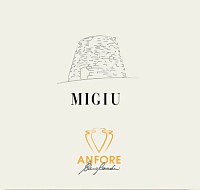
|
|
Migiu 2017 |
|
| Olianas (Sardinia, Italy) | |
 Semidano Semidano | |
| Price: € 22.00 | Score: |
 Brilliant amber yellow and nuances of amber yellow, transparent. Brilliant amber yellow and nuances of amber yellow, transparent. Intense, clean, pleasing and refined, starts with hints of quince, plum
and citrus fruits followed by aromas of hawthorn, mature peach, beeswax,
pear jam and almond. Intense, clean, pleasing and refined, starts with hints of quince, plum
and citrus fruits followed by aromas of hawthorn, mature peach, beeswax,
pear jam and almond.
 Crisp attack and however balanced by alcohol, good body, intense
flavors, agreeable. Crisp attack and however balanced by alcohol, good body, intense
flavors, agreeable.
 Persistent finish with flavors of quince, plum and mature peach. Persistent finish with flavors of quince, plum and mature peach. 5 months in amphora. 5 months in amphora. |
|
 Stuffed pasta, Roasted white meat, Roasted fish, Mushroom soups Stuffed pasta, Roasted white meat, Roasted fish, Mushroom soups |
|
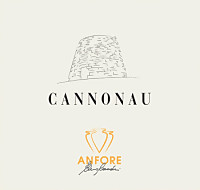
|
|
Cannonau di Sardegna Le Anfore 2017 |
|
| Olianas (Sardinia, Italy) | |
 Cannonau (95%), Alicante Bouschet (5%) Cannonau (95%), Alicante Bouschet (5%) | |
| Price: € 22.00 | Score: |
 Brilliant ruby red and nuances of ruby red, moderate transparency. Brilliant ruby red and nuances of ruby red, moderate transparency. Intense, clean, pleasing and refined, starts with hints of plum,
strawberry and raspberry followed by aromas of violet, black cherry,
blueberry, geranium, pomegranate and myrtle. Intense, clean, pleasing and refined, starts with hints of plum,
strawberry and raspberry followed by aromas of violet, black cherry,
blueberry, geranium, pomegranate and myrtle.
 Properly tannic attack and however balanced by alcohol, good body,
intense flavors, pleasing crispness. Properly tannic attack and however balanced by alcohol, good body,
intense flavors, pleasing crispness.
 Persistent finish with flavors of plum, raspberry and strawberry. Persistent finish with flavors of plum, raspberry and strawberry. 6 months in amphora, 5 months in bottle. 6 months in amphora, 5 months in bottle. |
|
 Broiled meat and barbecue, Roasted meat, Stewed meat with mushrooms, Cheese Broiled meat and barbecue, Roasted meat, Stewed meat with mushrooms, Cheese |
|
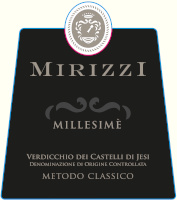
|
|
Verdicchio dei Castelli di Jesi Spumante Metodo Classico Extra Brut Mirizzi 2017 |
|
| Montecappone (Marches, Italy) | |
 Verdicchio Verdicchio | |
| Price: € 23.00 | Score: |
 Brilliant straw yellow and nuances of straw yellow, very transparent,
fine and persistent perlage. Brilliant straw yellow and nuances of straw yellow, very transparent,
fine and persistent perlage.
 Intense, clean, pleasing and refined, starts with hints of apple, plum
and bread crust followed by aromas of peach, hawthorn, pear, linden, broom
and almond. Intense, clean, pleasing and refined, starts with hints of apple, plum
and bread crust followed by aromas of peach, hawthorn, pear, linden, broom
and almond.
 Effervescent and crisp attack, however balanced by alcohol, good body,
intense flavors, agreeable. Effervescent and crisp attack, however balanced by alcohol, good body,
intense flavors, agreeable.
 Persistent finish with flavors of apple, plum and peach. Persistent finish with flavors of apple, plum and peach. Refermented in bottle on its lees for 24 months. Refermented in bottle on its lees for 24 months. |
|
 Pasta and risotto with crustaceans and fish, Roasted white meat, Roasted fish, Mushroom soups Pasta and risotto with crustaceans and fish, Roasted white meat, Roasted fish, Mushroom soups |
|
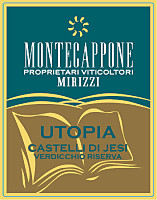
|
|
Verdicchio dei Castelli di Jesi Classico Superiore Riserva Utopia Mirizzi 2015 |
|
| Montecappone (Marches, Italy) | |
 Verdicchio Verdicchio | |
| Price: € 17.50 | Score: |
 Brilliant straw yellow and nuances of straw yellow, very transparent. Brilliant straw yellow and nuances of straw yellow, very transparent. Intense, clean, pleasing, refined and elegant, starts with hints of
plum, apple and citron followed by aromas of pear, medlar, hawthorn, peach,
pineapple, chamomile, broom, jasmine, thyme and almond. Intense, clean, pleasing, refined and elegant, starts with hints of
plum, apple and citron followed by aromas of pear, medlar, hawthorn, peach,
pineapple, chamomile, broom, jasmine, thyme and almond.
 Crisp attack and however balanced by alcohol, good body, intense
flavors, agreeable. Crisp attack and however balanced by alcohol, good body, intense
flavors, agreeable.
 Very persistent finish with long flavors of plum, apple and citron. Very persistent finish with long flavors of plum, apple and citron. 9 months in steel tanks. 9 months in steel tanks. |
|
 Pasta with fish, Sauteed white meat, Stewed fish, Fried fish, Cheese Pasta with fish, Sauteed white meat, Stewed fish, Fried fish, Cheese |
|

|
|
Colli della Serra 2013 |
|
| Alberto Quacquarini (Marches, Italy) | |
 Vernaccia Nera (25%), Sangiovese (25%), Merlot (25%), Cabernet Sauvignon (25%) Vernaccia Nera (25%), Sangiovese (25%), Merlot (25%), Cabernet Sauvignon (25%) | |
| Price: € 13.00 | Score: |
 Intense ruby red and nuances of garnet red, little transparency. Intense ruby red and nuances of garnet red, little transparency. Intense, clean, pleasing and refined, starts with hints of plum, black
cherry and dried violet followed by aromas of blueberry, carob, black
pepper, mace, licorice, tobacco, vanilla and menthol. Intense, clean, pleasing and refined, starts with hints of plum, black
cherry and dried violet followed by aromas of blueberry, carob, black
pepper, mace, licorice, tobacco, vanilla and menthol.
 Properly tannic attack and however balanced by alcohol, good body,
intense flavors, agreeable. Properly tannic attack and however balanced by alcohol, good body,
intense flavors, agreeable.
 Persistent finish with flavors of plum, black cherry and blueberry. Persistent finish with flavors of plum, black cherry and blueberry. 24 months in cask and barrique. 24 months in cask and barrique. |
|
 Broiled meat and barbecue, Roasted meat, Stewed meat with mushrooms, Hard cheese Broiled meat and barbecue, Roasted meat, Stewed meat with mushrooms, Hard cheese |
|

|
|
Petronio 2012 |
|
| Alberto Quacquarini (Marches, Italy) | |
 Vernaccia Nera Vernaccia Nera | |
| Price: € 28.00 | Score: |
 Intense ruby red and nuances of garnet red, little transparency. Intense ruby red and nuances of garnet red, little transparency. Intense, clean, pleasing and refined, starts with hints of plum,
blackberry and dried violet followed by aromas of black cherry, blueberry,
dried rose, tamarind, carob, cocoa, tobacco, vanilla and menthol. Intense, clean, pleasing and refined, starts with hints of plum,
blackberry and dried violet followed by aromas of black cherry, blueberry,
dried rose, tamarind, carob, cocoa, tobacco, vanilla and menthol.
 Properly tannic attack and however balanced by alcohol, good body,
intense flavors, pleasing roundness. Properly tannic attack and however balanced by alcohol, good body,
intense flavors, pleasing roundness.
 Persistent finish with flavors of plum, blackberry and black cherry. Persistent finish with flavors of plum, blackberry and black cherry. 30 months in barrique. 30 months in barrique. |
|
 Broiled meat and barbecue, Roasted meat, Stewed meat with mushrooms, Hard cheese Broiled meat and barbecue, Roasted meat, Stewed meat with mushrooms, Hard cheese |
|

|
|
Propizio 2017 |
|
| Donato Giangirolami (Latium, Italy) | |
 Grechetto Grechetto | |
| Price: € 7.40 | Score: |
 Intense golde yellow and nuances of golden yellow, very transparent. Intense golde yellow and nuances of golden yellow, very transparent. Intense, clean, pleasing and refined, starts with hints of apple, plum
and hawthorn followed by aromas of citrus fruits, peach, pear, broom,
pineapple and hazelnut. Intense, clean, pleasing and refined, starts with hints of apple, plum
and hawthorn followed by aromas of citrus fruits, peach, pear, broom,
pineapple and hazelnut.
 Crisp attack and however balanced by alcohol, good body, intense
flavors, agreeable. Crisp attack and however balanced by alcohol, good body, intense
flavors, agreeable.
 Persistent finish with flavors of apple, plum and pear. Persistent finish with flavors of apple, plum and pear. 6 months in steel tanks. 6 months in steel tanks. |
|
 Pasta with fish, Sauteed white meat, Roasted fish, Fried fish Pasta with fish, Sauteed white meat, Roasted fish, Fried fish |
|

|
|
Peschio 2014 |
|
| Donato Giangirolami (Latium, Italy) | |
 Cabernet Sauvignon (50%), Petit Verdot (50%) Cabernet Sauvignon (50%), Petit Verdot (50%) | |
| Price: € 9.90 | Score: |
 Deep ruby red and nuances of ruby red, little transparency. Deep ruby red and nuances of ruby red, little transparency. Intense, clean, pleasing and refined, starts with hints of black
currant, black cherry and blueberry followed by aromas of violet, plum,
peony, blackberry, chocolate, tobacco, vanilla and eucalyptus. Intense, clean, pleasing and refined, starts with hints of black
currant, black cherry and blueberry followed by aromas of violet, plum,
peony, blackberry, chocolate, tobacco, vanilla and eucalyptus.
 Properly tannic attack and however balanced by alcohol, good body,
intense flavors, agreeable. Properly tannic attack and however balanced by alcohol, good body,
intense flavors, agreeable.
 Persistent finish with flavors of black currant, black cherry and
blueberry. Persistent finish with flavors of black currant, black cherry and
blueberry.
 18 months in cask. 18 months in cask. |
|
 Broiled meat and barbecue, Roasted meat, Stewed meat with mushrooms, Cheese Broiled meat and barbecue, Roasted meat, Stewed meat with mushrooms, Cheese |
|
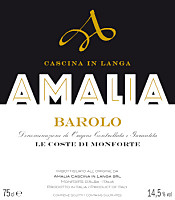
|
|
Barolo Le Coste di Monforte 2013 |
|
| Amalia (Piedmont, Italy) | |
 Nebbiolo Nebbiolo | |
| Price: € 35.00 | Score: |
 Brilliant ruby red and nuances of garnet red, moderate transparency. Brilliant ruby red and nuances of garnet red, moderate transparency. Intense, clean, pleasing, refined and elegant, starts with hints of
cherry, plum and violet followed by aromas of raspberry, blueberry,
strawberry, rose, tobacco, pink pepper, chocolate, cinnamon, licorice,
vanilla and menthol. Intense, clean, pleasing, refined and elegant, starts with hints of
cherry, plum and violet followed by aromas of raspberry, blueberry,
strawberry, rose, tobacco, pink pepper, chocolate, cinnamon, licorice,
vanilla and menthol.
 Tannic attack and however balanced by alcohol, full body, intense
flavors, pleasing crispness. Tannic attack and however balanced by alcohol, full body, intense
flavors, pleasing crispness.
 Persistent finish with flavors of cherry, plum and raspberry. Persistent finish with flavors of cherry, plum and raspberry. 30 months in cask. 30 months in cask. |
|
 Game, Roasted meat, Stewed and braised meat, Hard cheese Game, Roasted meat, Stewed and braised meat, Hard cheese |
|

|
|
Barolo Bussia 2013 |
|
| Amalia (Piedmont, Italy) | |
 Nebbiolo Nebbiolo | |
| Price: € 35.00 | Score: |
 Brilliant ruby red and nuances of garnet red, little transparency. Brilliant ruby red and nuances of garnet red, little transparency. Intense, clean, pleasing, refined and elegant, starts with hints of
cherry, plum and violet followed by aromas of raspberry, rose, strawberry,
red orange, tobacco, cinnamon, cocoa, pink pepper, licorice, vanilla and
menthol. Intense, clean, pleasing, refined and elegant, starts with hints of
cherry, plum and violet followed by aromas of raspberry, rose, strawberry,
red orange, tobacco, cinnamon, cocoa, pink pepper, licorice, vanilla and
menthol.
 Tannic attack and however balanced by alcohol, full body, intense
flavors, pleasing crispness. Tannic attack and however balanced by alcohol, full body, intense
flavors, pleasing crispness.
 Persistent finish with flavors of cherry, plum and raspberry. Persistent finish with flavors of cherry, plum and raspberry. 24 months in cask. 24 months in cask. |
|
 Game, Roasted meat, Stewed and braised meat, Hard cheese Game, Roasted meat, Stewed and braised meat, Hard cheese |
|
News |
|
In this section are published news and information about events concerning the world of wine and food. Whoever is interested in publishing this kind of information can send us a mail to our address.
|
AquavitaeReview of Grappa, Distillates and Brandy |
|
|
||||||||||||
Wine Guide ParadeDecember 2018
|
| |||||||
Privacy Policy | |||||||


| Copyright © 2002-2024 Antonello Biancalana, DiWineTaste - All rights reserved |
| All rights reserved under international copyright conventions. No part of this publication and of this WEB site may be
reproduced or utilized in any form or by any means, electronic or mechanical, without permission in writing from DiWineTaste. |